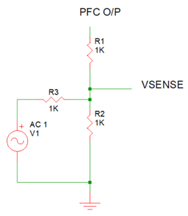Other Parts Discussed in Thread: UCC28180, UCC28019A
In my current design, the output voltage needs to be adjustable. To do this, the resistor divider for the VSENSE will have its bottom resistor connected to a variable voltage source instead of GND. When this voltage source is zero, the output voltage will be maximum. The resistor dividers for VSENSE and VINAC will be made identical as usual and the normal setup will be valid when the voltage source is zero. As far as I can see, the reason that these resistor dividers are made equal is for the current synthesizer. When the added voltage source is not zero, the current synthesizer will not work properly. However, I will not be using the current synthesizer, and I don't see any reason that this modified arrangement will cause any problems. Is there any other function inside the UCC28070 that would be thrown off by this arrangement?



